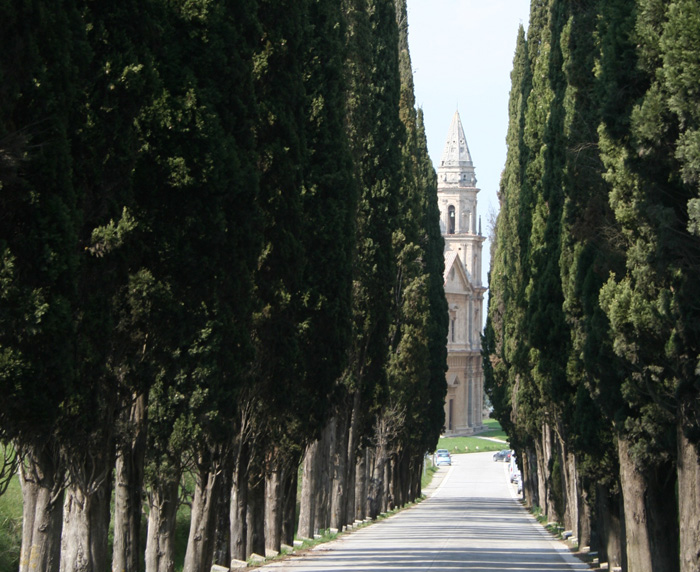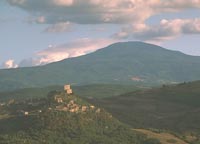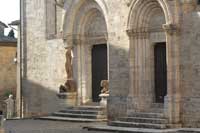| |
|
 |
 |
|
![Toacana ] Galleria di immagini](/titels/albump.gif) |
|
| |
 |
|
|
| |
|
|
|
|
| |
|
Chiefly known for its good local 'Vino Nobile' wines, Montepulciano lies to the southeast of Siena, on the summit of one of the hills that separates the Valdichiana from the Val d'Orcia. It is built along a narrow limestone ridge at 605m above sea level. The town is encircled by walls and fortifications designed by Antonio da Sangallo the Elder in 1511 for Cosimo I, and inside the walls the streets are crammed with Renaissance-style palazzi, churches, restaurants, shops and a fabulous atmosphere. Of Etruscan origin, Montepulciano later became a Roman winter encampment.
Montepulciano has a fortress dating back to the 8th century and medieval palazzi from the 13th century. The main square 'Piazza Grande' is surrounded by magnificent buildings such as the Palazzo Publico, the Cathedral with unfinished façade begun in 1594 from a design by Ippolito Scalza, and several residences by Vignola, Sangallo and Peruzzi.
The pilgrimage Church of the Madonna di San Biagio lies just outside of the town of Montepulciano. Its symmetrical greek-cross plan reflects the High Renaissance drive towards perfection in a combination of squares and circles.
The church was begun by the architect Antonio di Sangallo the Elder in 1518 and is considered one of the first great examples of Cinquecento architecture.
|
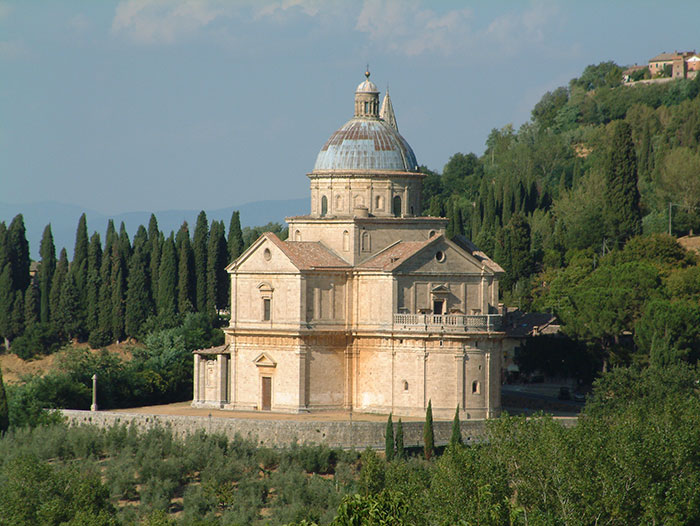 |
Montepulciano, San Biagio.
Photo, Josep Renalias [1]
|
The concept for a centrally planned church obsessed High Renaissance architects like Francesco di Giorgio Martini, Leonardo, Antonio di Sangallo the Elder and the Younger, Bramante, and Michelangelo. This is based on the Vitruvian idea that man, which represents perfection, can fit into both a square and a circle. As man provides the measure for these forms, if we create a space based on a combination of these forms, we are likely to understand that space inherantly. So, many plans for churches in the Cinquecento were based on greek cross plans and tried to combine these perfect shapes. But, many ACTUAL churches do not! Due to the impraticality of not having a nave down which to process, architects and patrons often found the need to give the space a certain directionality by differentiating at least the apse. S. Biagio is in fact one of these cases, but it comes very close to the Renaissance ideal. As you can see in the ground plan, the whole complex except the rounded apse fits into a square that can be, of course, subdivided into smaller squares.
The church as it stands today took about a hundred years to complete, and in fact it was never finished according to plan. You approach it from the side that has a rounded apse. Going around to the right side, this would have been the facade, which was planned to have two identical towers. One tower was completed while the other stands as an odd, incomplete structure. The towers flanking this side would have provided a sense of directional axis towards the apse. The central core of the structure is articulated by three flat facades that appear to be identical; the rounded apse occupies the lower part of a fourth facade that also provides this repetition in design.
|

|
Montepulciano - Madonna di San Biagio, Interior [1]
|
The interior is a a beautiful open space that, at certain times of day, is illuminated by dramatic directional light. The sense of symmetry is apparent as one observes the equal vaults on three sides. The interior is entirely decorated in travertine. Architectural elements like engaged columns and Doric or Tuscan pilasters offer repetition and division of space. The arches are punctuated by strongly extruding rosettes. The vocabulary is a specific ancient one that references the Basilica Aemilia in the Roman Forum, as has been observed by Lehmann in 1982
Events in Montepulciano
Montepulciano house several events: the Bruscello (traditional theatre), the Bravio delle botti (a barrel contest) and the Palio dei carretti in Valiano (a traditional cart contest).
Il Bruscello
The "Bruscello", a theatrical parade and performances in front of the Duomo in Montepulciano,takes place on August 14th, 15th (Assumption Day) and 16th August, when actors present scenes taken from the towns’ history.
Il Bravio delle botti
Piazza Grande is the heart of Montepulciano and the setting for its main events, including the Bravio delle Botti contest held in August every year. The Bravio delle Botti, a hard race run pushing wine barrels uphill, takes place on the last Sunday in August between the eight Contradas of Montepulciano.
Events in Montepulciano | Il Bruscello and Il Bravio delle botti
|
|
|
|
| |
|
Vino Nobile di Montepulciano is a red wine with a Denominazione di Origine Controllata e Garantita status produced in the vineyards surrounding the town of Montepulciano, Italy.[1] The wine is made primarily from the Sangiovese grape varietal (known locally as Prugnolo gentile) (minimum 70%), blended with Canaiolo Nero (10%–20%) and small amounts of other local varieties such as Mammolo. The wine is aged for 2 years (at least 1 year in oak barrels); three years if it is a riserva.
|
 |
San Biagio and Vino Nobile di Montepulciano vineyards [2]
|
|
|
| |
|
|
Maremma is the name given to the southernmost area of Tuscany. The rolling hills of this area are famous for their unspoilt natural beauty. Hidden away from mass-tourism, discover a piece of Italy which remains largely unchanged both nature and lifestyle-wise. The peacefulness of the countryside, the various unique villages and the friendly atmosphere will no doubt pleasantly surprise you. Tuscany is one of the most popular tourist destinations in the world. Known for its enchanting landscapes, its fantastic and genuine food and beautiful towns as Florence, Pisa, Lucca and Siena. Podere Santa Pia is located on the edge of the green hills of the Val d'Orcia and the Valle d'Ombrone begins, and one can easily reach some of the most beautiful attractions of Tuscany, such as Montalcino, Pienza, Montepulciano and San Quirico d'Orcia, famous for their artistic heritage, wine, olive oil production and gastronomic traditions.
|
| |
|
|
|
|
|
|
|
|
|
Podere Santa Pia |
|
Podere Santa Pia |
|
Rocca di Tentennano
|
|
|
|
|
|
Pienza |
|
Montalcino |
|
San Quirico d'Orcia
|
Tuscany
Just off the busy roads you turn into the rural landscape of the fertile Arno valley with it's undulating hills adorned by fine historic villas. The bright and varied landscape is recognisably that which forms the background of Florentine quattrocento paintings. This is an area rich in history and tradition, where the splendid Etruscan and Renaissance civilizations grew up and flourished. Florence was at the heart of the Renaissance, and so also of the cultural development of Tuscan Italy. Fiesole and the area North of Florence has a wealth of Etruscan and Roman sites. Siena is easily reached by the delightfully scenic Via Chiantigiana, as are attractive medieval walled towns like San Gimignano or Monteriggione, with walls ringed by Dante's fourteen 'giants'. Pisa and Lucca are just as accessible and fascinating. You can laze away the days in the sun in complete tranquillity, or wander through the superb and varying landscape. The hills themselves and the traditional stone houses offer a coolness welcome in the summer; but they are almost more beautiful with their rich colouring in autumn, when of course, the cities are also less crowded.
The landscape ot the Val d'Orcia as it unfolds nowadays was created by wealthy Siennese merchants in the 14th and 15th centuries. The farms cultivate mainly grains, vines and olives. Rows of cypresses are also a distinctive sight. The beauty of the area inspired Renaissance painters and early travellers on Via Francigena. Podere Santa Pia is located on the southern border of Val d'Orcia Park, close to Pienza, Montepulciano, Montalcino, Radicofani and San Quirico d'Orcia.
Vino Nobile di Montepulciano is one of the most famous and culturally significant wines in Tuscany, a region famous for its wine-making prowess. It is not to be confused with the Montepulciano grape variety which is used throughout many regions of Italy and is used to make wines such as Montepulciano d’Abruzzo.
The area of the Vino Nobile di Montepulciano is situated between the Val d'Orcia (Orcia Valley) and the Val di Chiana (Chiana Valley), and borders in the east with Umbria. The road starts in the north with Abbadia towards Montepulciano, passing Cervognano, Acquaviva until S. Albino.
Although notice of the town's wine dates as far back to 790 AD, it was the poet and doctor Francesco Redi who widely established the fame of the wine in a famous poem, Bacco in Toscana in which he toured the great Tuscan wine regions of his day with Bacchus and Ariadne at his side. Redi stated, "Montepulciano is the King of all wines."
Only after two years of storage the wine can be called Vino Nobile di Montepulciano. This wine was the first one classified as DOCG and is one of the most important Italian wine types byond the Italian bounds. Already in the 17th century, Francesco Redi called this wine the king of the Tuscan wine. The Rosso di Montepulciano, classified as DOC-wine is not aged for two years in wood barrels and is intended for the immediate consumption.
In 1980 Vino Nobile di Montepulciano was granted the Denominazione di Origine Controllata e Garantita.
Tuscany | Strada del Vino Nobile di Montepulciano
|
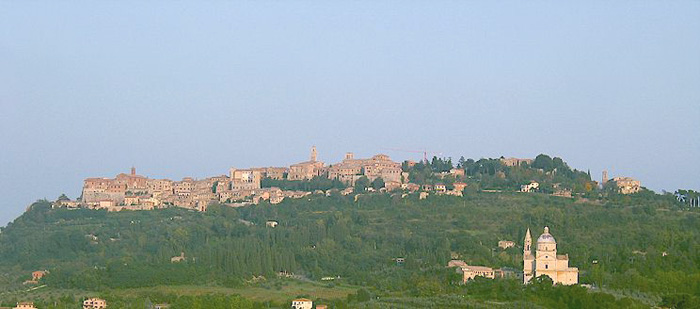 |
Monbepulciao, perched on a hill that rises between the Val di Chiana and the Val d’Orcia. The legend has it that Montepulciano was founded by the mythical Etruscan king Porsenna. More likely its origin are as the property of the Roman family of the Publicii, from which derived the name of “Monte Publiciano”.
|

[0] Foto Rein Ergo. All rights reserved © Traveling in Tuscany.
[1] Foto di Josep Renalias, licenziato in base ai termini della licenza Creative Commons Attribuzione-Condividi allo stesso modo 3.0 Unported
[2] Photo by Simona, published under a Attribution-NonCommercial-NoDerivs 2.0 Generic (CC BY-NC-ND 2.0) license.
|
|
|
| |
|
|
|
| |
|
|
|
| |
|
|
|
| |
|
|
|
| |
|
|
|
| |
|
|
|



